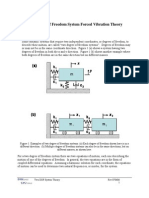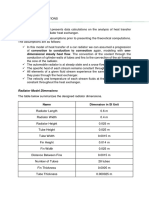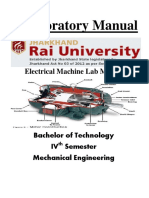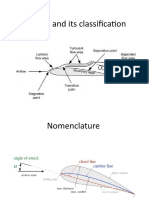Theory: Forced Vibration of Two Degrees of Freedom System
Theory: Forced Vibration of Two Degrees of Freedom System
Uploaded by
ettypasewangCopyright:
Available Formats
Theory: Forced Vibration of Two Degrees of Freedom System
Theory: Forced Vibration of Two Degrees of Freedom System
Uploaded by
ettypasewangOriginal Title
Copyright
Available Formats
Share this document
Did you find this document useful?
Is this content inappropriate?
Copyright:
Available Formats
Theory: Forced Vibration of Two Degrees of Freedom System
Theory: Forced Vibration of Two Degrees of Freedom System
Uploaded by
ettypasewangCopyright:
Available Formats
Forced vibration of 2 degree of freedom system
SOLVE the virtual lab@ NITK Surathkal Machine Dynamics and Vibration Lab
Forced vibration of two degrees of freedom system
Theory
Learning objectives
After completing this simulation experiment one should be able to
- Model a given real system to an equivalent simplified two degree system and studying
its free vibration and forced vibration response with suitable assumptions /
idealisations.
- Calculate the natural frequency vibration and the amplitude of vibration for the give
excitation force of given two degree freedom system.
Forced vibration of 2 degree of freedom system
Introduction
Analysing real system as a single degree system is an approximate assumption. Because real
system has more than just one degree of freedom and are also very rarely linear. It requires
several degrees of freedom for a meaningful model. Hence a simple 1DOF systems analysis
is not much helpful in studying the characteristics of the system. A natural extension of single
degree of freedom system is to consider the system as two degree of freedom models.
A System that requires two independent coordinates to describe their motion is called
two degree-of-freedom systems. Some practical examples of two degree freedom systems
shown in Fig 2, like as forging hammer anvil supported in its base, which in turn is
supported on ground isolators, a reciprocating engine with a damper, a relatively light shaft
with two disks as in a turbocharger rotor, a generator driving a motor through a coupling. For
a two degree of freedom system there are two equations of motion, each one describing the
motion of one of the degrees of freedom. In general, the two equations are in the form of
coupled differential equations.
Fig 1: Two DOF systems modelling of a forging hammer
Forced vibration of 2 degree of freedom system
SOLVE the virtual lab@ NITK Surathkal Machine Dynamics and Vibration Lab
Fig 2: Two DOF system modelling of a motor generator set up.
A simplified two degree of freedom system is shown in Fig 3. The motion of the
system is completely described by the coordinates and x
1
(t) and x
2
(t) which defines the
positions of the masses m
1
and m
2
at any time t from the respective equilibrium positions. The
external F
1
(t) and F
2
(t) respectively. The free-body diagrams of the masses and are shown in
Fig. 1(b).
Fig 3: A two degree of freedom spring mass system
Equations of motion of 2 degree of freedom system are given by:
1 1 1 1 2 1 2 1
( ) ( ) mx k x k x x F t + + = ...(1)
2 2 2 2 1 2
( ) ( ) m x k x x F t + = ...(2)
Free vibration analysis:
For the free-vibration analysis of the system shown in Fig 1, we set F
1
(t) =F
2
(t) =0. The
equation 1 and 2 reduces to,
1 1 1 1 2 1 2
( ) 0 mx k x k x x + + = ...(3)
2 2 2 2 1
( ) 0 m x k x x + = ...(4)
Forced vibration of 2 degree of freedom system
SOLVE the virtual lab@ NITK Surathkal Machine Dynamics and Vibration Lab
Let us assume the solutions for x
1
and x
2
under steady state conditions as harmonic
excitations with the same frequency and phase angle but with different amplitudes and are
given by,
1 1
sin( ) x X t e | = + and
2 2
sin( ) x X t e | = +
...(5)
By substituting equation 5 in 3 and 4 we have,
{ }
2
1 2 1 2 1 2 2
( ) 0 m k k k X k X e + + =
...(6)
2
2 1 2 2 2
( ) 0 k X m k X e + + =
. ..(7)
Natural frequency of vibration of the system found by solving equation 6 and 7 and is given
by,
2 2 1 2 2 1 2
1 2
1 2
1/ 2
2
2
1 2 2 1 2 1 2 2 2
1 2 1 2
( ) ) 1
,
2
( ) ) ( ) ) 1
4
2
n n
k k m mk
mm
k k m mk k k k k
mm mm
e e
+ +
=
`
)
(
+ + +
(
` `
(
) )
Resonance occurs when the exciting frequency coincides with any one of the natural
frequency of the system.
Forced vibration analysis:
For the forced-vibration analysis of the system shown in Fig 3, the system is excited by either
of harmonic forcing functions F
1
(t) and F
2
(t) or both. But for the specific case, we assume
the system is excited by harmonic force F
1
(t) = F
0
sin t.
The equation of motion of the two degree freedom system reduces to,
1 1 1 1 2 1 2 0
( ) sin mx k x k x x F t e + + =
...(8)
2 2 2 2 1
( ) 0 m x k x x + =
...(9)
When harmonic forcing function acts on the system, the solution consist of transient part and
the steady state part. In steady state part the vibration of any point in the system take place
at the frequency of excitation. Let us assume , for the steady state , the solution as,
1 1
sin( ) x X t e | = + and
2 2
sin( ) x X t e | = +
...(10)
Substituting equation 10 in 8 and 9, we will get,
{ }
2
1 2 1 2 1 2 2 0
( ) m k k k X k X F e + + =
...(11)
2
2 1 2 2 2
( ) 0 k X m k X e + + =
...(12)
By solving equation 11 and 12 we get,
( )
{ }
2
2 2
1
4 2
1 2 1 2 2 1 2 1 2
( )
k m
X
mm mk m k k k k
e
e e
=
( + + +
...(5)
and
Forced vibration of 2 degree of freedom system
SOLVE the virtual lab@ NITK Surathkal Machine Dynamics and Vibration Lab
{ }
2 0
2
4 2
1 2 1 2 2 1 2 1 2
( )
k F
X
mm mk m k k k k e e
=
( + + +
...(6)
The above two equations give the steady state amplitude of vibration of two masses
respectively as a function of forcing frequency .
Lets try to understand these equations by doing a few simple simulations, go to next tab
procedure to find out how to run the simulation to EXPLORE (expR) and to EXPERIMENT
(expT). A talking tutorial or a self-running demo with narration can be seen at EXPLAIN
(expN)
You might also like
- Mece307 - Sertaç ŞimşekDocument18 pagesMece307 - Sertaç ŞimşekErtürk ErdiNo ratings yet
- Assignment 1 - Closed Loop DynamicsDocument12 pagesAssignment 1 - Closed Loop DynamicsTharaka AmarasiriNo ratings yet
- AEEC432 Rectilinear ControlDocument46 pagesAEEC432 Rectilinear ControlMelina Andrea ZiccorNo ratings yet
- Study of Basic Elements of Various Power PlantsDocument3 pagesStudy of Basic Elements of Various Power PlantsRajendrakumar B Varia67% (3)
- DR KC Yadav, Director, Jindal Institute of Power TechnologyDocument75 pagesDR KC Yadav, Director, Jindal Institute of Power TechnologyPrudhvi RajNo ratings yet
- Examples MomentumDocument9 pagesExamples Momentumettypasewang0% (1)
- Frac Limited Entry PerfDocument5 pagesFrac Limited Entry PerfJesús SalazarNo ratings yet
- Astm D5393 - 08 PDFDocument9 pagesAstm D5393 - 08 PDFCaio Mussi TarantoNo ratings yet
- Vibrations of Two Degree of Freedom SystemsDocument28 pagesVibrations of Two Degree of Freedom SystemsKautilyaChennaNo ratings yet
- Theory For Two Degree of Freedom SystemsDocument4 pagesTheory For Two Degree of Freedom SystemsRajiv ThambotheranNo ratings yet
- CH 4 - The Vibrations of Systems Having TDOFDocument17 pagesCH 4 - The Vibrations of Systems Having TDOFEmad ElsaidNo ratings yet
- Vibrations 2dofDocument29 pagesVibrations 2dofbhukthaNo ratings yet
- Two-Degree-of-Freedom SystemsDocument19 pagesTwo-Degree-of-Freedom SystemsMarwan NasserNo ratings yet
- EE2101 Unit5Document2 pagesEE2101 Unit5Sadyant HbpNo ratings yet
- Car Radiator Design CalculationsDocument6 pagesCar Radiator Design CalculationsTIMOTHY JAMES ALMASA100% (1)
- Electrical Machine PDFDocument40 pagesElectrical Machine PDFAanjenay PandeyNo ratings yet
- Chapter 03Document89 pagesChapter 03KIÊN HOÀNG TRUNGNo ratings yet
- Dynamics of Machinery Oral Question BankDocument22 pagesDynamics of Machinery Oral Question BankSurajKahateRajputNo ratings yet
- VD Cls NotesDocument56 pagesVD Cls NotesAzhagiriNo ratings yet
- Tensile Testing of Ferrous and Non-Ferrous AlloyDocument7 pagesTensile Testing of Ferrous and Non-Ferrous Alloyrama100% (1)
- Thick Wall Cylinder: Module Name: ME2061 Semester: 3Document27 pagesThick Wall Cylinder: Module Name: ME2061 Semester: 3Awishka EashanNo ratings yet
- Heat 4Document4 pagesHeat 4Kasar nagib 2002No ratings yet
- DOM - Governor NotesDocument17 pagesDOM - Governor NotesEssKay0% (1)
- Damped Free VibrationDocument26 pagesDamped Free VibrationPriyamvada BijuNo ratings yet
- MCE 233 Mechanics of Machines III Part 1Document42 pagesMCE 233 Mechanics of Machines III Part 1Emmanuel KutaniNo ratings yet
- TM QPDocument25 pagesTM QPB K Santosh SanthuNo ratings yet
- Thermal Conductivity of Composite Slab: Vishwakarma Institute Technology, Pune ofDocument7 pagesThermal Conductivity of Composite Slab: Vishwakarma Institute Technology, Pune ofHussain MagarNo ratings yet
- CH 03c, Coulomb Damping in Free Vibration of SDOFDocument10 pagesCH 03c, Coulomb Damping in Free Vibration of SDOFAtalelew ZeruNo ratings yet
- Vibration Isolation and Force Transmissibility - 6Document50 pagesVibration Isolation and Force Transmissibility - 6Jay PrasathNo ratings yet
- Exercise 19 - Drilling Machine With Gravity Feed Magazine: 1. Abbreviated Notation 1A+ 2A+ 2A-1A - 3A+ 3ADocument5 pagesExercise 19 - Drilling Machine With Gravity Feed Magazine: 1. Abbreviated Notation 1A+ 2A+ 2A-1A - 3A+ 3AyashveerluvNo ratings yet
- Combustion AssignmentDocument30 pagesCombustion AssignmentMichael AlvarezNo ratings yet
- Mechanical Translational Systems QuestionsDocument6 pagesMechanical Translational Systems Questionsdjun033No ratings yet
- Lecture # 13Document22 pagesLecture # 13Rahil BalochNo ratings yet
- Solved Problems 4-2022-2023 FallDocument9 pagesSolved Problems 4-2022-2023 FallErtürk ErdiNo ratings yet
- Mechanical Vibration WorksheetDocument6 pagesMechanical Vibration Worksheetduraiprakash83No ratings yet
- All Applications For 1st and Higher Order ODEs - Ch1Document29 pagesAll Applications For 1st and Higher Order ODEs - Ch1Rafi SulaimanNo ratings yet
- Equivalent Masses Fundamentals of VibrationDocument14 pagesEquivalent Masses Fundamentals of Vibrationghulam mohi ud dinNo ratings yet
- 21ME61 Set1&2Document6 pages21ME61 Set1&2prathapkumar2403No ratings yet
- Basicthermo Compiled TnshridharDocument129 pagesBasicthermo Compiled Tnshridharsohan2902No ratings yet
- Lectures 23-24 Chapter 15 Fall 2009Document28 pagesLectures 23-24 Chapter 15 Fall 2009tewari_skNo ratings yet
- Question Bank Unit IIDocument10 pagesQuestion Bank Unit IISachin BharadwajNo ratings yet
- ME 301 HW2 2016-2017 Fall SolutionDocument3 pagesME 301 HW2 2016-2017 Fall SolutionMeriç DinçbilekNo ratings yet
- Advanced Thermal and Fluid Engineering: (Email Address)Document16 pagesAdvanced Thermal and Fluid Engineering: (Email Address)Nidhin KakkanattuNo ratings yet
- Stabilty Routh HurwitzDocument33 pagesStabilty Routh HurwitzAhmad SherNo ratings yet
- Chapter 9 Gear TrainsDocument99 pagesChapter 9 Gear TrainsAmalina100% (1)
- Course Outline Mechanics Machines ME3033Document4 pagesCourse Outline Mechanics Machines ME3033Mohammad Faraz AkhterNo ratings yet
- Free Vibration of One Degree of Freedom Systems: Initial DeviationDocument8 pagesFree Vibration of One Degree of Freedom Systems: Initial DeviationEugine BalomagaNo ratings yet
- 9 Causes of Neutral To Earth - Ground Voltage - Effects & SolutionDocument12 pages9 Causes of Neutral To Earth - Ground Voltage - Effects & SolutionArshad BadushaNo ratings yet
- Euler Turbomachinery Equation PDFDocument2 pagesEuler Turbomachinery Equation PDFChadNo ratings yet
- D-Alembert Principle and Lagrange's EquationsDocument9 pagesD-Alembert Principle and Lagrange's EquationsShakeel Ahmad KasuriNo ratings yet
- Simulation of Simple PendulumDocument6 pagesSimulation of Simple PenduluminventionjournalsNo ratings yet
- 3-Gauss Elimination MethodDocument12 pages3-Gauss Elimination MethodsirfmeinNo ratings yet
- Symmetrical Fault Analysis PDFDocument16 pagesSymmetrical Fault Analysis PDFlimkokchiang809No ratings yet
- DR - Safaa Hameed Faisal Heat Transfer LectureDocument1 pageDR - Safaa Hameed Faisal Heat Transfer LectureSafaa Hameed Al Nasery100% (1)
- Models - Mbd.washing Machine Vibration PDFDocument36 pagesModels - Mbd.washing Machine Vibration PDFgf-antaresNo ratings yet
- MIT2 003SCF11 Pset9 SolDocument10 pagesMIT2 003SCF11 Pset9 SolDasaka BrahmendraNo ratings yet
- Elem Handouts Topics 1&2Document10 pagesElem Handouts Topics 1&2Escalona, Michael Joshua S.No ratings yet
- Introductory Applications of Partial Differential Equations: With Emphasis on Wave Propagation and DiffusionFrom EverandIntroductory Applications of Partial Differential Equations: With Emphasis on Wave Propagation and DiffusionNo ratings yet
- Forced Vibration of Two Degrees of Freedom SystemDocument4 pagesForced Vibration of Two Degrees of Freedom Systemsethu sharanyaNo ratings yet
- Chapter-6: Energy Method (Lagrange's Method)Document35 pagesChapter-6: Energy Method (Lagrange's Method)ideepujNo ratings yet
- 2dof 1Document122 pages2dof 1wanpudinNo ratings yet
- Eme 516Document11 pagesEme 516VictorNo ratings yet
- Introducing The GEK Gasifier Systems - Rev3Document18 pagesIntroducing The GEK Gasifier Systems - Rev3ettypasewangNo ratings yet
- Module 5 Extrusion-Lecture 3Document9 pagesModule 5 Extrusion-Lecture 3udaygwlNo ratings yet
- Introduction To System Modeling: Dynamic System Input U (T) Output y (T)Document19 pagesIntroduction To System Modeling: Dynamic System Input U (T) Output y (T)ettypasewangNo ratings yet
- Weatherwax Grewal SolutionsDocument94 pagesWeatherwax Grewal SolutionsettypasewangNo ratings yet
- Mechanics Ch5Document24 pagesMechanics Ch5ettypasewangNo ratings yet
- Module 7 Sheet Metal-Forming Lecture 1Document9 pagesModule 7 Sheet Metal-Forming Lecture 1ettypasewangNo ratings yet
- Mechanics Ch2Document38 pagesMechanics Ch2Reeja MathewNo ratings yet
- Tut 101 GPKDocument14 pagesTut 101 GPKettypasewangNo ratings yet
- Tut 003 VehicleGearboxWithPlanetaryDifferential EDocument35 pagesTut 003 VehicleGearboxWithPlanetaryDifferential EettypasewangNo ratings yet
- Calculation Sheet: Esign Xample Esign of A Two Span Trapezoidal Roof SheetingDocument8 pagesCalculation Sheet: Esign Xample Esign of A Two Span Trapezoidal Roof SheetingettypasewangNo ratings yet
- Topic C: Energy - Examples SPRING 2014: V V V V e 0.0 e 0.5 e 1.0Document9 pagesTopic C: Energy - Examples SPRING 2014: V V V V e 0.0 e 0.5 e 1.0ettypasewangNo ratings yet
- MoM Expt01 Theory Vel G4bar Ver01Document1 pageMoM Expt01 Theory Vel G4bar Ver01ettypasewangNo ratings yet
- Free Vibration Sdof System - Expt ProcedureDocument6 pagesFree Vibration Sdof System - Expt ProcedureettypasewangNo ratings yet
- Answers For Section 1 Spring 2009: Answer: X 50 MMDocument2 pagesAnswers For Section 1 Spring 2009: Answer: X 50 MMettypasewangNo ratings yet
- Dynamics of Motorcycle Using Flexible Elements: Salvatore Massimo Oliveri, Michele Calì and Leonardo CatalanoDocument10 pagesDynamics of Motorcycle Using Flexible Elements: Salvatore Massimo Oliveri, Michele Calì and Leonardo CatalanoettypasewangNo ratings yet
- 6 Screw CompressorDocument68 pages6 Screw CompressorYuri DuriNo ratings yet
- Flat Joint Contact ModelDocument14 pagesFlat Joint Contact ModelVivekChaudharyNo ratings yet
- Hanging DowncomerDocument11 pagesHanging DowncomerPablo C. T.No ratings yet
- Q4-Science-9-Week 2Document4 pagesQ4-Science-9-Week 2jholan debelenNo ratings yet
- Suzuki Jimny Brochure AustraliaDocument11 pagesSuzuki Jimny Brochure AustraliaAnthony Baker100% (1)
- Bearings 1Document1 pageBearings 1Joydev GangulyNo ratings yet
- Gearinmesh - Matlab Program For Calculating The Geometry of Involute GearsDocument13 pagesGearinmesh - Matlab Program For Calculating The Geometry of Involute GearsakshatNo ratings yet
- Kinematics of MachinesDocument3 pagesKinematics of MachinesNshuti Rene FabriceNo ratings yet
- Global The Source Catalog WebDocument100 pagesGlobal The Source Catalog WebJenifer Piña gonzalesNo ratings yet
- Ekeeda - Mechanical Engineering - Strength of MaterialsDocument11 pagesEkeeda - Mechanical Engineering - Strength of MaterialsMANISH KUMARNo ratings yet
- Pressure Vessel Handbook 10th Edition Megyesy PDFDocument864 pagesPressure Vessel Handbook 10th Edition Megyesy PDFamanmittal08No ratings yet
- Em-30-01-01-Mr-26 (KM Chan 17.11.2022)Document15 pagesEm-30-01-01-Mr-26 (KM Chan 17.11.2022)Scienscope SDN BHDNo ratings yet
- Simpson 1984 Flexible Orifice PlatesDocument4 pagesSimpson 1984 Flexible Orifice Platesfelipe muñozNo ratings yet
- The Task of 5-Axis Milling PDFDocument4 pagesThe Task of 5-Axis Milling PDFManikanda PrabhucNo ratings yet
- Aerofoil ClassificationDocument10 pagesAerofoil ClassificationSridhar KanagarajNo ratings yet
- CaseHard BS970-1955EN36ADocument2 pagesCaseHard BS970-1955EN36AtechzonesNo ratings yet
- Introduction To ANSYS MechanicalDocument31 pagesIntroduction To ANSYS MechanicalKevin TsuiNo ratings yet
- Tranport Phenomena PresntationDocument27 pagesTranport Phenomena PresntationAbdur RehmanNo ratings yet
- Tutorial 4 - AnswersDocument20 pagesTutorial 4 - AnswersYathurshanNo ratings yet
- Fabrication Sequence PDFDocument38 pagesFabrication Sequence PDFharry_1981100% (7)
- Engine Lubrication Systems Theory SupportDocument13 pagesEngine Lubrication Systems Theory SupportEngr.shamiNo ratings yet
- Modulating Control (Operating Procedure)Document32 pagesModulating Control (Operating Procedure)goodgranitNo ratings yet
- Idn 38.24 - Coal Shed Lombok - Tower Support - Re01 - 2024.07Document57 pagesIdn 38.24 - Coal Shed Lombok - Tower Support - Re01 - 2024.07k9anh.1999No ratings yet
- Flojet G57-5205 Parts List: Your On-Line Source For Pumps and Parts!Document3 pagesFlojet G57-5205 Parts List: Your On-Line Source For Pumps and Parts!Dolores FuertesNo ratings yet
- Group 1 Highway and Railroad VillaruelDocument45 pagesGroup 1 Highway and Railroad Villarueljoselle guevarraNo ratings yet
- Hydro Electric Power PlantDocument12 pagesHydro Electric Power PlantLopirts Nigani100% (1)
- 3412 Overhaul Parts ListDocument5 pages3412 Overhaul Parts ListMr Min Kyaw ThuNo ratings yet








































































































